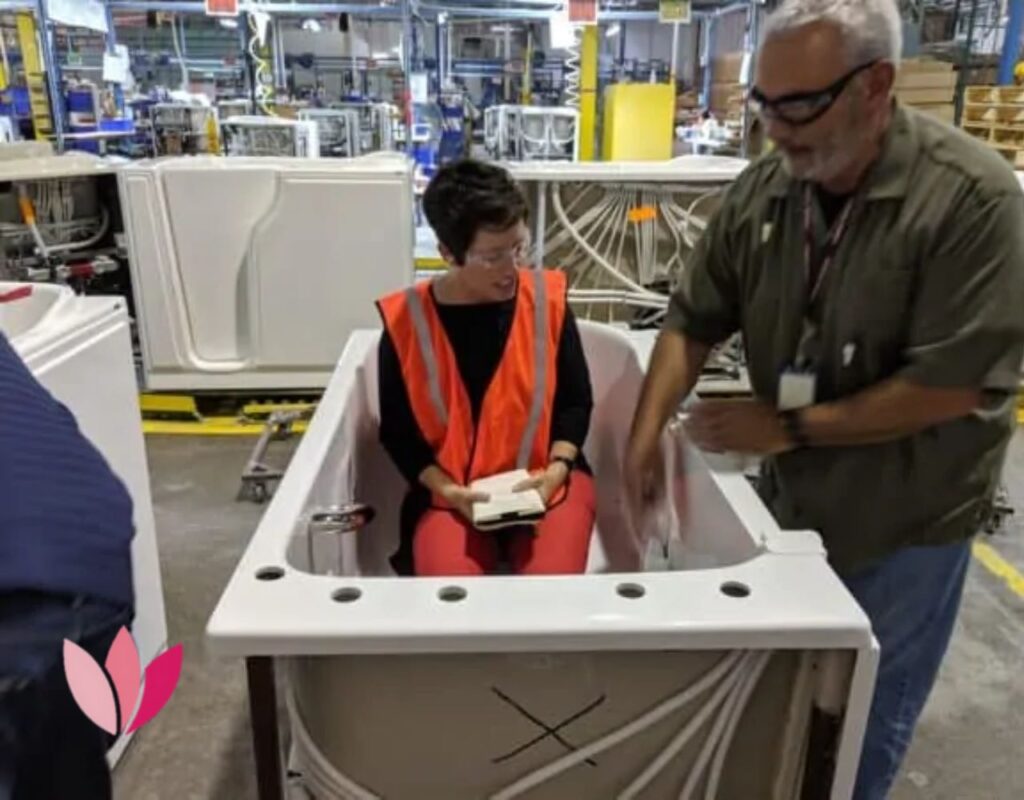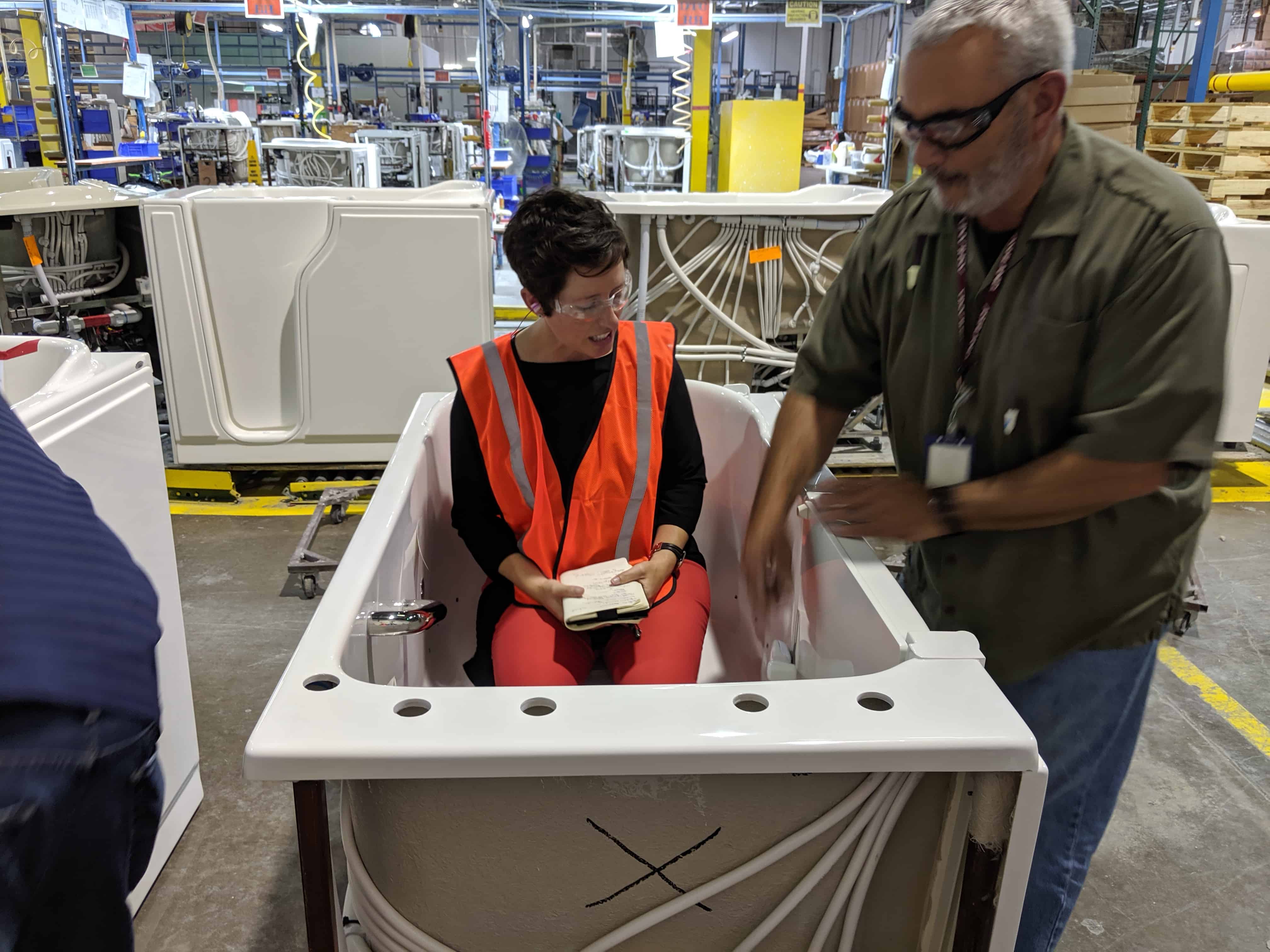The Best Walk-In Tub Manufacturers of 2025


If you’re hoping to age in place, a walk-in tub is one of the best ways to make your home safe for the long haul. These bathroom fixtures, with a combination of low entry thresholds and non-slip surfaces, can prevent falls, a leading cause of injury for older adults.1
Through my years as a caregiver, I have seen firsthand how walk-in tubs can prevent injury and alleviate the stress that comes from bathing. Through personal experience with my clients and consultations with manufacturers, I’ve created this list of the best walk-in tub manufacturers, in which I’ve ranked my favorite brands by cost, installation, safety, and comfort.
In case of falls in the bathroom, it’s always good to have a medical alert system. To learn more, read my guide to the best medical alert systems.
|
Kohler
 |
American Standard
|
Safe Step
 |
|
|---|---|---|---|
| Rating out of 5 | 4.9 | 4.7 | 4.4 |
| Price range (excludes installation) |
$2,000-$20,000+ |
$6,544-$9,641 |
$2,500 to $20,000 (includes installation) |
| Standout features |
|
|
|
| Read More | Kohler Review | American Standard Review | Safe Step Review |
None of these walk-in tubs made the list, but they could still work for certain groups of people.
Amazon really is the everything store, and has walk-in tubs starting at just $1,799, which is the lowest price I’ve come across. But keep in mind that once you buy the tub, you’re on your own in terms of installation, and the customer service experience may be less than ideal.
Home Depot also offers a wide range of tubs starting at just $1,899.99. That being said, the company won’t carry the tub inside your home; it will only leave it on your curb, so getting it in your bathroom and installed may not be worth the headache.
Also a manufacturer of stair lifts, AmeriGlide offers walk-in tubs and conversion kits, which can convert your existing tub into a walk-in version. While converting a traditional tub sounds intriguing, our team has yet to test this offering.
A walk-in tub makes bath time much easier and safer for anyone with mobility issues, including seniors. Climbing in and out of a standard bathtub can be risky for anyone who suffers from balance problems, joint problems, stiffness, or weakness. It’s all too easy to lose balance and fall, which could result in bruises or even broken bones. A walk-in tub is much easier and safer to get into.

FYI: While Medicare won’t pay for some of the costs of a walk-in tub, there are other forms of financial assistance available. To learn more, check out my guide to paying for a walk-in tub.
A good walk-in tub should have the following safety features:
Anti-scald shower heads regulate the temperature of the water coming out of the showerhead or faucet, even if someone turns a tap on or switches on a water-using appliance elsewhere in the house. This is vital to protect delicate skin from burns.
Slips and falls are a risk for elderly people. Walk-in tubs should come with anti-slip floors and seats to help reduce the risk of falls.
Look for a quick-release drain feature that lets the bath user (or a caregiver or EMT) hit a button and drain the bath rapidly to prevent accidental immersion. Quick drain systems also make waiting for the bath to drain more comfortable, as users don’t have to sit for a long time before opening the door to leave.
Many seniors are a little unsteady, especially when entering or exiting a tub or moving from a sitting to standing position. Check for ample safety bars for users to grab.
The above-listed safety features are a must. I also recommend you look out for:
Many users who choose a walk-in tub do so because climbing into a standard tub is hard for them. Look for a low threshold to make sure the walk-in tub is easy to enter.
A wider door makes it easier to get in and out of the tub, especially for larger users, or those who suffer from stiffness or pain in their hips.
No one wants a buildup of mold or harmful bacteria in the water lines! Check that the system you choose is self-cleaning to keep water lines flushed and hygienic.
Any good tub should have a leakproof door seal with a lifetime guarantee to prevent bathroom flooding.
A walk-in tub is a considerable investment. Be sure when purchasing yours that you’re guaranteed for life in case of any problems.
Check out the controls on your tub of choice and make sure they’re easy to press, even for arthritic hands.
There are several kinds of walk-in tubs to suit different budgets and needs. Here are the most common.
These are the most common walk-in tubs for home use, as they tend to be both the cheapest and the best to look at. For general use for an older adult with no special requirements (such as needing an extra-large or wheelchair-accessible tub), these are a good choice.
While not as common as an inward swinging door, an outward swinging door is safer and easier for people with restricted mobility.
Bariatric walk-in tubs are made for those who weigh 300 pounds or more. They’re very similar to inward swinging tubs and have all the same safety features, but are larger and sturdier with a wider entrance.
Also known as slide-in tubs, these walk-ins have a wider entrance and no step to climb over, making them ideal for wheelchair users who can be helped from their chair and into the seat. They’re larger and more expensive and take up more space due to their outward opening door, but for wheelchair users, they make bath time much simpler.
Studies continually find that older adults overwhelmingly want to stay in their homes as opposed to moving to senior care communities.4 When chosen properly, a walk-in tub can help make this possible.
With so many options to choose from, deciding on a walk-in tub can seem challenging. Follow these steps to find the right one for you.
With so many choices on the market, you are sure to find the best walk-in tub for the senior in your life. You can also read my guide on buying a walk-in tub to kick-start your process.
To evaluate each walk-in tub manufacturer, I used the following criteria.
There’s no way around it; a walk-in tub will cost you several thousand dollars at a minimum. However, I looked for companies that cut costs where possible and gave preference to those that included installation in their estimates.
Ideally, the company should do the installation for you from start to finish. A lower-priced tub may seem like a bargain, but keep in mind that you’ll have to find people to install it and pay them handsomely.
Ultimately, a walk-in tub is meant to keep its bathers safe, so I looked for low entry thresholds, anti-slip surfaces, and ergonomic seats.
Safety aside, many of my favorite walk-in tub manufacturers implemented luxurious features like chromotherapy, heated seats, and quick-acting drains.
Of course, I value the experiences of my clients, which is why I picked the top three companies that I did. These companies were the most reliable and provided safe bathtubs that kept seniors in their homes rather than in nursing homes.
Walk-in tub prices vary widely. Kohler tubs range from $2,000-$20,000+, American Standard from $6,544-$9,641, and Safe Step from $2,500-$20,000 (installed). Budget options start at $1,899 from retailers like Home Depot and Amazon, but these require separate installation.
Look for anti-scald systems, anti-slip floors and seats, quick drains, grab bars, and low entryways (3-4 inches). Also, consider wider doors, leakproof seals with lifetime guarantees, and controls that are easy to use, even with arthritis.
Kohler and Safe Step both offer lifetime limited warranties on their walk-in tubs, making them the best options for long-term protection. American Standard provides a 5-15 year warranty on bathtub components, with a lifetime warranty specifically on door seals. The lifetime warranties from Kohler and Safe Step provide the most comprehensive coverage for your investment.
Installation policies vary by manufacturer. Safe Step includes professional installation in their pricing ($2,500-$20,000 total). American Standard handles installation through their authorized dealers. Kohler offers in-house installation with costs ranging $2,500-$8,000 separately. Budget retailers like Amazon and Home Depot typically don’t include installation, requiring you to arrange it independently.
Bariatric tubs are built tough with extra-wide doors that can accommodate larger people. If you use a wheelchair, slide-in tubs are designed for easy transfers, with no step to worry about and doors that swing out. Just make sure you have enough bathroom space for them.